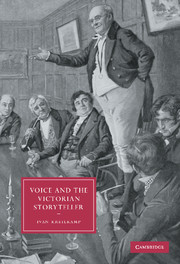Book contents
- Frontmatter
- Contents
- Acknowledgments
- 1 “The best man of all”: mythologies of the storyteller
- 2 When good speech acts go bad: the voice of industrial fiction
- 3 Speech on paper: Charles Dickens, Victorian phonography, and the reform of writing
- 4 “Done to death”: Dickens and the author's voice
- 5 Unuttered: withheld speech in Jane Eyre and Villette
- 6 “Hell's masterpiece of print”: voice, face, and print in The Ring and the Book
- 7 A voice without a body: the phonographic logic of Heart of Darkness
- Notes
- Bibliography
- Index
- CAMBRIDGE STUDIES IN NINETEENTH-CENTURY LITERATURE AND CULTURE
4 - “Done to death”: Dickens and the author's voice
Published online by Cambridge University Press: 22 September 2009
- Frontmatter
- Contents
- Acknowledgments
- 1 “The best man of all”: mythologies of the storyteller
- 2 When good speech acts go bad: the voice of industrial fiction
- 3 Speech on paper: Charles Dickens, Victorian phonography, and the reform of writing
- 4 “Done to death”: Dickens and the author's voice
- 5 Unuttered: withheld speech in Jane Eyre and Villette
- 6 “Hell's masterpiece of print”: voice, face, and print in The Ring and the Book
- 7 A voice without a body: the phonographic logic of Heart of Darkness
- Notes
- Bibliography
- Index
- CAMBRIDGE STUDIES IN NINETEENTH-CENTURY LITERATURE AND CULTURE
Summary
Roger Chartier argues that our understanding of print culture and the literary public sphere suffers from a tendency to overlook the performative dimension of literature. He notes that notwithstanding the rigid separation we tend to draw between print and oral culture, overlaps of reading practices
associate the spoken word and writing: either a spoken word fixes itself in writing or, conversely, a text returns in oral form through the mediation of reading out loud. Other overlaps connect writing and gestures … The history of cultural practices must consider these interpenetrations and restore some of the complex trajectories that run from the spoken word to the written text, from writing that is read to gestures that are performed, from the printed book to reading aloud.
(Chartier, “Texts, Printing, Readings,” pp. 170–1)This chapter takes such an approach to speech and writing in examining the career of Charles Dickens and the location of his own reading performances within it. Of all major Victorian bodies of fiction, certainly none is more thoroughly embedded in modes of vocal performance than his. Eugene Wrayburn in Our Mutual Friend testifies to the strong link between reading and performance for Dickens:
By-the-bye, that very word, Reading, in its critical use, always charms me. An actress's Reading of a chambermaid, a dancer's Reading of a hornpipe, a singer's Reading of a song, a marine painter's Reading of the sea, the kettle-drum's Reading of an instrumental passage, are phrases ever youthful and delightful.
(Dickens, Our Mutual Friend, p. 542)- Type
- Chapter
- Information
- Voice and the Victorian Storyteller , pp. 89 - 121Publisher: Cambridge University PressPrint publication year: 2005
- 1
- Cited by



